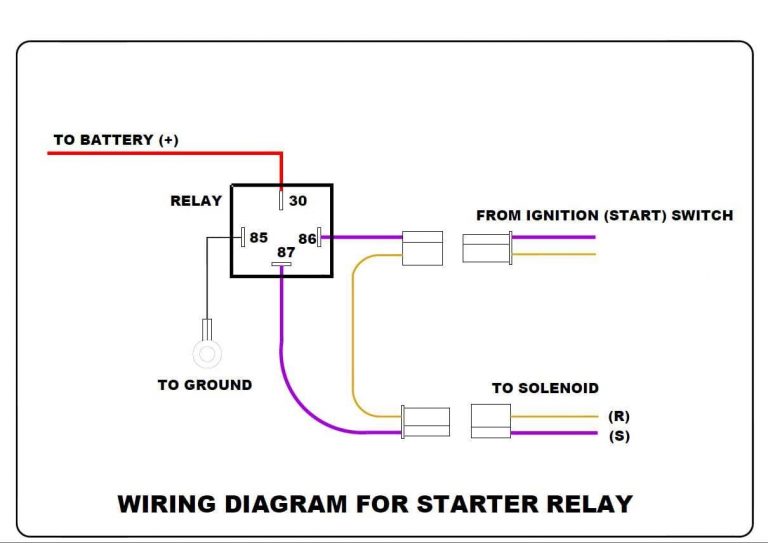How to Check a Starter Relay
To check a starter relay, locate it in the engine compartment and visually inspect for any signs of damage or corrosion. Then, test the relay using a multimeter to ensure it is functioning properly.
When diagnosing issues with your vehicle’s starting system, one crucial component to consider is the starter relay. A faulty starter relay can prevent the engine from turning over, leading to frustrating and inconvenient situations. By understanding how to check and troubleshoot the starter relay, you can quickly identify any issues and take the necessary steps to repair or replace the faulty component.
We will guide you through the process of checking a starter relay to ensure your vehicle starts smoothly every time.

Credit: www.aliontimer.com
Importance Of Starter Relay
The starter relay plays a crucial role in a vehicle’s electrical system, as it controls the flow of electricity to the starter motor. To check if the starter relay is functioning properly, one can perform a simple test using a multimeter to measure the continuity and resistance.
This helps ensure the reliable starting of the vehicle.
Function Of Starter Relay
A starter relay is a crucial component of a vehicle’s ignition system. Its primary function is to control the electrical current that is sent to the starter motor. When you turn the ignition key, the starter relay allows the battery power to flow to the starter motor, which then initiates the engine’s cranking process. Essentially, the starter relay acts as a switch, enabling the starter motor to engage and start the engine.
Signs Of A Faulty Starter Relay
Identifying a faulty starter relay is essential to maintain the smooth operation of your vehicle. If your car exhibits any of the following signs, it could indicate a problem with the starter relay:
- The engine cranks slowly or fails to start altogether.
- You hear a clicking sound when turning the ignition key.
- The electrical system experiences intermittent failures.
- The starter motor remains engaged even after the engine has started.
- The vehicle’s lights dim when attempting to start the engine.
Note: It’s important to note that these symptoms can also be caused by other issues within the ignition system. Therefore, it is recommended to consult a professional mechanic to accurately diagnose and resolve any problems.
If you suspect a faulty starter relay, it is advisable to address the issue promptly. Ignoring the warning signs can lead to additional damage to the starter motor or other electrical components. Additionally, a malfunctioning starter relay can leave you stranded in inconvenient and potentially unsafe situations.
| Advantages | Disadvantages |
|---|---|
|
|
In conclusion, the starter relay plays a vital role in the ignition system of a vehicle. It allows for the efficient flow of electrical power to the starter motor, enabling the engine to start smoothly. Recognizing the signs of a faulty starter relay and taking appropriate action can help you avoid inconvenience and costly repairs. Remember to consult a qualified mechanic for accurate diagnosis and resolution of any issues.

Credit: m.youtube.com
Tools Required
To check a starter relay, you will need the following tools:
Multimeter
A multimeter helps measure electrical voltage and continuity in a circuit.
Screwdriver
A screwdriver is used to remove the starter relay from the vehicle for testing.
Locating The Starter Relay
Locating the Starter Relay can sometimes feel like searching for a needle in a haystack. Thankfully, with a bit of guidance, you can easily pinpoint the exact location of this crucial component in your vehicle.
Identifying The Relay Box
Start by locating the relay box in your vehicle. Common locations include near the battery, in the engine compartment, or under the dashboard. Refer to your owner’s manual for specifics.
Finding The Starter Relay Within The Box
Once you’ve located the relay box, the next step is to find the Starter Relay inside. This relay is typically more substantial than the others and may be labeled as “Starter Relay” or have a diagram indicating its function.
Testing The Starter Relay
When it comes to troubleshooting issues with your car’s starting system, one component that could be the culprit is the starter relay. The starter relay is responsible for sending power from the battery to the starter motor, allowing it to start the engine. If the starter relay is faulty, it can prevent the engine from turning over. To determine if the starter relay is the problem, you can perform a few simple tests. In this post, we will walk you through how to check a starter relay by testing for continuity and checking for voltage.
Testing For Continuity
If you suspect that the starter relay may be faulty, the first step is to test for continuity. Continuity testing helps you determine if there is an unbroken electrical path between two points. To test for continuity in the starter relay, follow these steps:
- Disconnect the negative terminal of the battery to prevent any accidental electrical discharge.
- Locate the starter relay, which is usually found in the engine compartment or under the dashboard.
- Remove the starter relay from its socket, if necessary, by gently pulling it out.
- Using a multimeter set to the continuity or resistance mode, touch one probe to the relay’s control terminal and the other to the relay’s battery terminal.
- If the multimeter displays a reading close to zero or beeps, it indicates that there is continuity and the starter relay is functioning properly.
- If the multimeter does not display any reading or remains in an open circuit state, it indicates that there is no continuity and the starter relay needs to be replaced.
Checking For Voltage
Another way to test the starter relay is by checking for voltage at its terminals. This test will help you identify if the relay is receiving the necessary power supply. Here’s how you can check for voltage in the starter relay:
- Reconnect the negative terminal of the battery.
- Locate the starter relay and remove it from its socket, if necessary.
- Switch the ignition to the “ON” position without starting the engine.
- Place the positive probe of a multimeter on the relay’s control terminal and the negative probe on a metal ground.
- If the multimeter displays a voltage reading close to the car battery’s voltage, it means that power is reaching the relay, and it is likely functioning properly.
- If there is no voltage reading or a significantly lower voltage reading, it suggests that there may be an issue with the power supply, and further inspection is required.
By performing these tests for continuity and voltage, you can determine if the starter relay is the cause of your car’s starting problems. Remember to exercise caution and consult a professional if you are unsure or uncomfortable with performing these tests yourself. With proper troubleshooting, you can quickly diagnose and resolve issues with your car’s starter relay.
Replacing A Faulty Starter Relay
When it comes to replacing a faulty starter relay, understanding how to remove the old relay and install the new one is essential. By following simple steps, you can ensure a smooth replacement process and get your vehicle back on the road in no time.
Removing The Old Relay
Before starting the removal process, ensure that the vehicle’s battery is disconnected to prevent any electrical mishaps. Locate the old starter relay, which is typically positioned near the battery or the engine compartment.
- Identify the relay: The relay is a small, square or rectangular component plugged into the relay box. It is often labeled with the letters “S” or “ST” for starter relay.
- Disconnect the wiring: Carefully remove the wiring harness attached to the relay by gently pressing the release tab and pulling it off.
- Unbolt the relay: Using a socket wrench, unbolt the old relay from the relay box. Keep the bolts in a safe place to use with the new relay.
Installing The New Relay
Once the old relay is removed, it’s time to install the new starter relay to ensure proper functioning of the vehicle’s starting system.
- Position the new relay: Place the new relay in the same position from which you removed the old one, ensuring that it is firmly seated in the relay box.
- Bolt the new relay: Using the bolts saved from the old relay, secure the new relay in place by tightening the bolts with the socket wrench.
- Connect the wiring: Carefully attach the wiring harness to the new relay, ensuring it clicks securely into place.

Credit: www.youtube.com
Frequently Asked Questions Of How To Check A Starter Relay
How Do You Know If Your Starter Relay Is Bad?
A bad starter relay can be identified by several signs. The most common indicators are a vehicle that won’t start, all lights turning on but no engine cranking, or a clicking sound coming from the relay. If you experience any of these issues, it’s likely that your starter relay needs to be replaced.
How Do You Test A Start Relay?
To test a start relay, use a multimeter to check for continuity between terminals. Ensure no continuity between start and run terminals. Apply power to the coil terminal & listen for a click. If it clicks, the relay is functioning correctly.
How Do You Check A Relay With A Multimeter?
To check a relay with a multimeter, set it to ohms, place probes on coil terminals, and check for continuity.
What Are 2 Symptoms That Would Indicate A Faulty Starter Solenoid?
Two common symptoms of a faulty starter solenoid are a clicking sound when turning the key and the engine not starting at all.
How Do I Know If My Starter Relay Is Bad?
To check if your starter relay is bad, listen for a clicking noise when attempting to start the engine.
What Are The Symptoms Of A Faulty Starter Relay?
Symptoms of a faulty starter relay include the engine not starting, a clicking sound, and dimming headlights.
Can A Bad Starter Relay Drain The Battery?
Yes, a bad starter relay can cause a drain on the battery as it continues to draw power even when the engine is not running.
Conclusion
To wrap up, checking a starter relay is a vital part of maintaining your vehicle’s functionality. By following the step-by-step guide in this blog post, you can easily identify any issues with the starter relay and take appropriate action. Remember to use caution when working with electrical components, and consider seeking professional assistance if needed.
Regularly inspecting and servicing your vehicle’s starter relay will ensure smooth engine starts and avoid potential breakdowns. Stay proactive and keep your vehicle running smoothly.

